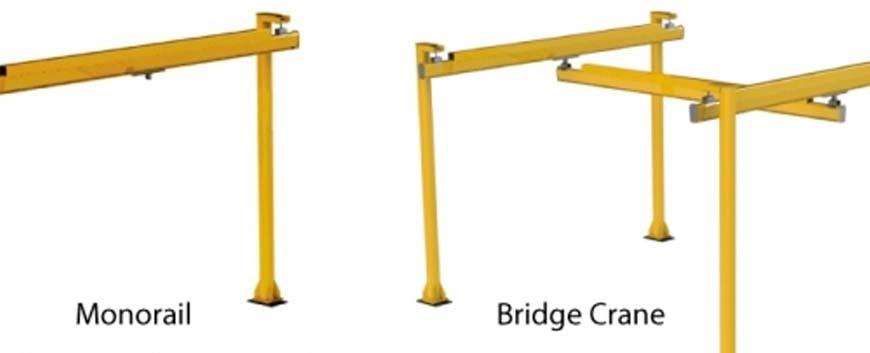In the world of construction, the need for machines and equipment that can lift loads of heavy materials with minimum effort and maximum safety is paramount. That is why monorail lifting systems have gained popularity in recent times.
A monorail lifting system comprises a series of trolleys, tracks, and monorail hoists used to lift heavy loads or move them horizontally over short distances. In this article, we will explore the basics of monorail lifting, how it differs from cranes, and its capacity.
What is a Monorail?
Traditionally, a monorail is a single rail section that is used to pass a load from one area to another on a single route typically on one axis, see image above.
Now there are curved monorails, similar to an overhead conveyor, that turns and routes around obstacles in the facility. Many times consumers do not know industry terminology and think that monorails are actually bridge cranes.
Bridge cranes consist of two sometimes three supporting rail sections, called runways, designed to carry the cross member, called the bridge, and traverse down the runways allowing the load to be moved in the X and Y axis.
Monorails lift systems are very efficient but only designed to move products in a predetermined pattern dictated by the monorail itself whereas a bridge crane system allows the user to cover a much larger area and control the placement of the load.
Utilizing a Monorail Lift System
Typically for a monorail lift system to be efficient it needs to be either suspended from a wide-span header system or suspended from the ceiling, if not the supports will interfere with the movement of the load that is being traversed.
Monorails and overhead conveyors are used in many auto manufacturing plants and high-speed production lines. This is to keep the assembly line moving at a consistent speed not allowing the product to deviate from the course set by the monorail section itself.
This movement restriction serves a very niche group of manufacturing compared to an overhead bridge crane system that allows the user to control the speed and direction at which the load travels.
The cost savings going with a monorail will be significant compared to a bridge crane system considering the monorail is basically one runway in and of itself.
What is the Difference Between a Monorail Hoist and a Crane?
The main difference between a monorail hoist and a crane that a monoral is one rail. A crane consists of two rails or runways, which can provide better lifting capacity, range of motion and flexibility. They can move in multiple directions and even rotate, while a monorail hoist can move up and down, and along the monorail lifting beam, whether that’s vertical, curved, or even branched.
Another difference is that cranes, such as Gantry cranes, can be transported, while monorails are typically a permanent fixture. Because of these differences, monorails are preferred in industries where the load’s route of travel is fixed, such as production or assembly lines in manufacturing plants.
Cranes are also typically built to handle larger weights, while monorail hoists are designed for lighter loads.
What is the Capacity of a Monorail Hoist?
The monorail lifting equipment’s capacity can range from a few hundred pounds to several tons, depending on the model. Typically, you can expect many monorails to fall within the 250kg to 10-ton range. While monorail lifting systems of 40000 lb are rare, they do exist.
It’s important to choose a hoist with the appropriate lifting capacity for your project as going beyond capacity can be dangerous.
You need to consider the size of the load and how it will be supported on the rail. Be sure to consult with a professional to determine the best monorail beam for lifting and hoisting for your project and ensure that safety protocols and OSHA standards are followed.
Your Choice
So the next time you are looking for a monorail lift system consider the product flow throughout your facility to determine which is the better investment for your company, a monorail or bridge crane system. Consider also your capacity needs, can the weight be taken care of by a monorail lifting crane or will you need a bridge crane?
Either way, whatever you decide, you are making a decision for not only the safety of your facility, but the future of your business.


